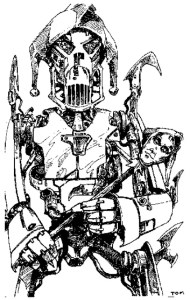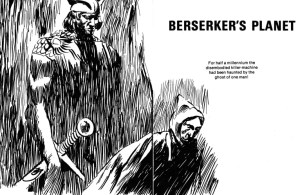
This post is brought to you by the Sudana & Zaar series by G. W. Thomas. The four tales of this duo and their fearless crew onboard the Boudicca can be found in Whispers of Sand and Ice, along with the Space Westerns of the planet Utukku. Sudana and her android friend also showed up in Ships of Steel with the novella “The Hidden Heart”, a tale of space pirates. (Now with a new price!)
Bring On the Action!
Publications specializing in “Adventure Science Fiction” are rare despite the impression the covers give. Amazing Stories, Astounding (especially later) and the other Pulps even including the more juvenile Captain Future, Thrilling Wonder Stories and Planet Stories never really promised slam-bag action. Certainly all of them had some exciting pieces, more or less depending on the editor. Science Fiction was a mix of action, ideas, travelogue and speculation. The first magazine to actually place “adventure” in the title was Isaac Asimov’s Science Fiction Adventure Magazine, which ran for four issues in 1978-1979.

Because of this mix of elements in good SF, a reader has to go looking for the more action-oriented pieces. This does not mean the tale will be wall-to-wall punch ups. The action may only be a small part of the story but the feel of the piece is not static or cerebral. Something happens! That might mean a stunner like Edmond Hamilton’s “The World With a Thousand Moons” (Amazing Stories, December 1942) or “Exploration Team” by Murray Leinster in Astounding Science Fiction, March 1956 . You might even find one in Weird Tales (July 1937) with “Raider of the Spaceways” by a young Henry Kutter. Action and adventure are where you find them. That being said, some places are more likely to bear fruit than others.
Galaxy Publishing
One of these is the magazines of Galaxy Publishing, who offered Galaxy (1950-1980), If or Worlds of If (1952-1974) and Worlds of Tomorrow (1963-1967/1970-1971). Now you may be thinking of the innovative early years of H. L. Gold’s Galaxy that gave us “To Serve Man” (“It’s a cookbook!”) and other more cutting edge stuff in response to John W. Campbell’s fossilization over at Astounding. Yes, these are the magazines, but I am looking at the later editors after Gold retired. Frederik Pohl in particular (1961-1969), Eiler Jakobsson (1969-1974) and finally Jim Baen (1974-1980).

Paul W. Fairman, who edited If, marked his territory right from the first issue, not infringing on Galaxy‘s mission to publish the best Science Fiction. Fairman seeks adventure-oriented stories from the get-go. He wrote:
We definitely will not talk ‘adult’ or “juvenile” relative to our contents as we feel such terms are misleading. We would rather think at all times in terms of “story”. Some of the greatest escapist literature ever written, Treasure Island for instance, could be put in either category or both. And if Edgar Rice Burroughs is juvenile, then so are we, because the late master has given us some memorable thrills.
Especially under the later editors, the trio of magazines gave us some classic Adventure SF: Keith Laumer’s Bolos and Retief, Fred Saberhagen’s Berserkers, the Gree stories of the highly under-rated C. C. MacApp as well as non-series works by Mack Reynolds, Lester Del Rey, Murray Leinster, not to mention the late fiction of E. E. “Doc” Smith. Now most of these writers sold to other magazines at the same time but the work they had in Fantasy & Science Fiction and elsewhere feels different. (Amazing Stories and Analog not so much.) This must have been a nice situation to find yourself in: editors who wanted action-y pieces, editors who wanted the think-ier tales. What it meant was that Science Fiction during the 1960s wasn’t all New Wave experimentation.
Keith Laumer
Bolo Stories
The Bolos are sentient tanks used in a number of different military tales. Two of the best appeared here.

“The Frozen Planet” (aka “Courier”) (If, September 1961)
“Night of the Trolls” (Worlds of Tomorrow, October 1963)
The rest appeared in Analog and F&SF
Retief Stories
Retief is a famous SF character, an envoy or diplomat for Earth. He is always saddled with ineffective superiors who have to be work around to save Terra from outside forces. These tales were based on Laumer’s own experience as a diplomat.

“Gambler’s World (aka “Palace Revolution”) (If, November 1961)
“The Yilian Way” (aka “Protocol”) (If, January 1962)
“The Mad Man From Earth (aka “Policy”) (If, March 1962)
“The Red Tape Mountain” (aka “Sealed Orders”) (If, May 1962)
“Aide Memoire” (If, July 1962)
“Cultural Exchange” (If, September 1962)
“The Desert ad the Stars” (If, November 1962)
“Saline Solution” (If, March 1963)
“Mightiest Qorn” (aka “Ultimatim”) (If, July 1963)
“The Governor of Glave” (aka “Native Intelligence”) (If, November 1963)
“The City That Grew in the Sea” (aka “Saline Solution”) (If, March 1964)
“The Prince and the Pirate” (If, August 1964)
“The Castle of Light” (If, October 1964)
“Retief, God Speaker” (aka “The Brass God”) (If, January 1965)
“Trick or Treaty”(If, August 1965)
“Giant Killer” (If, September 1965)

Retief’s War (If, October November December 1965)
“Dam Nuisance” (If, March 1966)
“Truce or Consequences” (If, November 1966)
“Forest in the Sky” (If, February 1967)
“Retief, War Criminal” (aka “The Forbidden City” (If, April 1967)
“Clear as Mud” (aka “Grime and Punishment”) (If, August 1967)
“Retief, the Long-Awaited Master” (aka “Mechanical Advantage” (If, April 1969)
“The Peace-Makers” (If, May-June 1970)
“Ballots & Bullets” (If, September-October 1970)
“Pime Doesn’t Cray” (Worlds of If, January-February 1971)
“Retief, Insider” (aka “Internal Affair’) (If, March-April 1971)
More stories and novels appeared elsewhere.
Fred Saberhagen
Berserker Stories
The Berserkers are gigantic killer machines from a forgotten space way. They are self-replicating and have smaller units that serve their desire to destroy all life. Saberhagen examines what it means to be human by countering that with cold, steel minds.

“Fortress Ship” (aka”Without a Thought”)(If, January 1963)
“Goodlife”(Worlds of Tomorrow, December 1963)
“The Lifehater” (aka “The Peacemaker”)(If, August 1964)
“Stone-Place”(If, March 1965)
“What T and I Did”(If, April 1965)
“The Sign of the Wolf” (If, May 1965)
“Patron of the Arts”(If, August 1965)
“The Masque of Red Shift”(If, November 1965)
“Mr. Jester”(If, January 1966)
“In the Temple of Mars”(If, April 1966)

“The Face of the Deep”(If, September 1966)
“The Stone Man”(Worlds of Tomorrow, May 1967)
“Berserker’s Prey” (aka “Pressure”)(If, June 1967)
“The Winged Helmet”(If, August 1967)
“Brother Berserker”(If, November 1967)
“Starsong”(If, January 1968)
“Wings Out of Shadow” (Worlds of If, March-April 1974)
Berserker Planet (May-June /July-August 1974)
“The Annihilation of Angkor Apeiron” (Galaxy, February 1975)
The series continued at Fantasy & Science Fiction and in novels
Larry Niven
Known Space
Larry’s early tales are set in the space we know, therefore “known space” such as Earth. The series would later includes Niven’s shared world anthologies of the Man-Kzin wars of which “Warrior” was the first story.

“The Coldest Place” (If, December 1964)
“World of Ptaavs” (Worlds of Tomorrow, March 1965)
“The Warriors” (If, February 1966)
“Eye of an Octopus” (Galaxy Magazine, February 1966)
“Neutron Star” (If, October 1966)
“How the heroes Die” (Galaxy Magazine, October 1966)
“At the Core” (If, November 1966)
“At the Bottom of a Hole” (Galaxy Magazine, December 1966)
“A Relic of the Empire” (If, December 1966)
“The Handicapped” (Galaxy Magazine, December 1967)

“The Soft Weapon” (If, February 1967)
“Flatlander” (If, March 1967)
“The Ethics of Madness” (If, April 1967)
“The Adults” (Galaxy Magazine, June 1967)
“The Deceivers” (Galaxy Magazine, April 1968)
“There Is a Tide” (Galaxy Magazine, July 1968)
“A Gift From Earth” (aka “Slowboat Cargo”) (If, February March April 1968)
Some of these stories appeared in F&SF and in anthologies. Later stories appeared in Analog.
C. C. MacApp
Omha Abides
The serialized novel was based on these stories about the Gaddyl. The magazine version has a different ending to the book.

“Under the Gaddyl” (Worlds of Tomorrow, April 1964)
“Trees Like Torches” (Worlds of Tomorrow, May 1966)
Gree Stories
The Gree are a race of enemies to Earth. The series are military or spy missions against this enemy.
“The Slaves of the Gree” (If, August 1964)
“Gree Commandos” (If, February 1965)
“Gree’s Hellcats” (If, April 1965)

“No Friend of Gree” (If, June 1965)
“Gree’s Damned Ones” (If, September 1965)
“Like Any World of Gree” (Worlds of Tomorrow, March 1966)
“Enemies of Gree” (If, September 1966)
“A Beachhead For Gree” (If, February 1967)
A. E. van Vogt
The Silkie Series
The Silkies are a special race that serves as intergalactic policemen. The three stories were combined for a fix-up novel.

“The Silkie” (If, July 1964)
“Silkies in Space” (If, May 1966)
“Enemies of the Silkies” (If, October 1967)
Some Novel Serials of Note

The Reefs of Space (If, July September November 1963) by Frederik Pohl and Jack Williamson
Farnham’s Freehold (If, July August October 1964) by Robert A. Heinlein
A Plague of Demons (If, November December 1964) by Keith Laumer
Starchild (If, January February March 1965) by Frederik Pohl and Jack Williamson
The Moon Is a Harsh Mistress (If, December 1965 January February March April 1966) by Robert A. Heinlein
Conclusion
It should be no surprise that writers like Larry Niven, Fred Saberhagen and Keith Laumer would dominate the paperbacks of the 1970s and beyond. Jim Baen would establish an entire publishing company for such works. It’s hard to believe they were ever young and obscure. The magazines like Galaxy, If and Worlds of Tomorrow (Analog after Campbell’s death is another) gave them places to publish their brand of Science Fiction. It doesn’t surprise me that the Berserkers, Retief, the Gree, the Silkies, the Kzin and others clustered here. Some grew beyond while others did not. (MacApp really deserves more readers. Check him out!) Just a side pleasure but the best of the illustrations for these mags were done by Jack Gaughan, another superstar to rise from the 1960s.
Discover these RAGE m a c h i n e SF books




